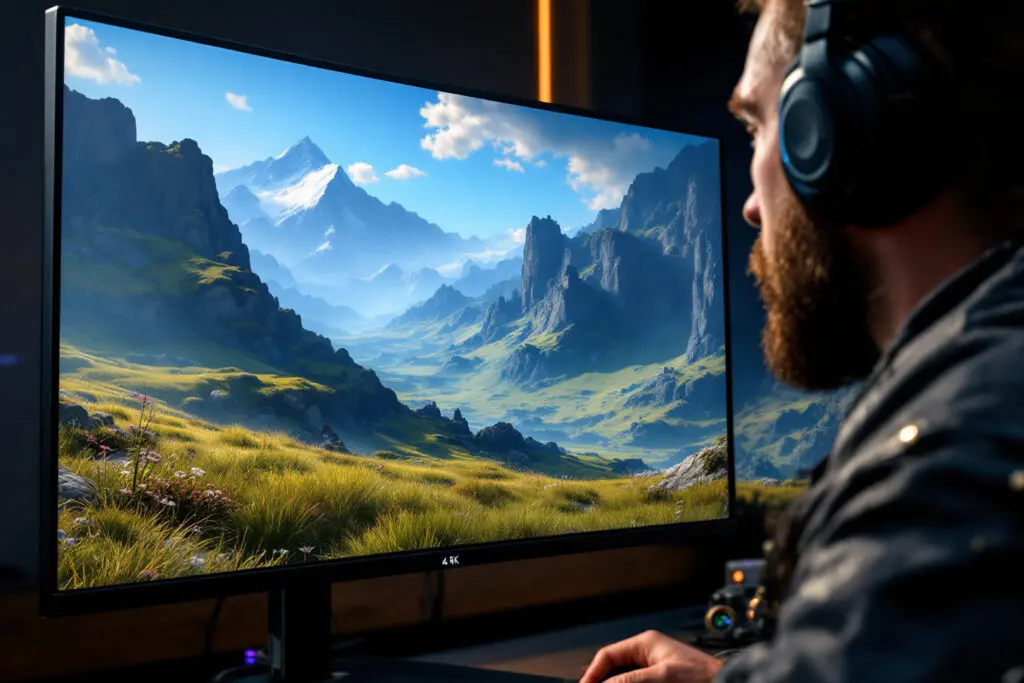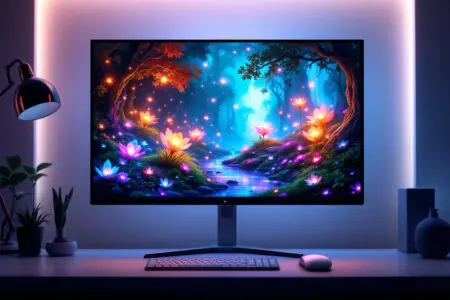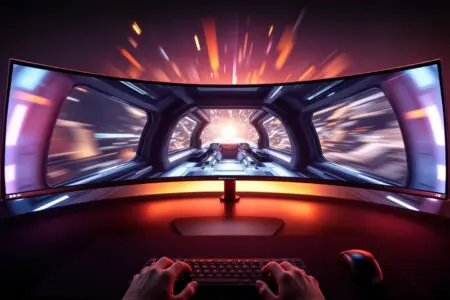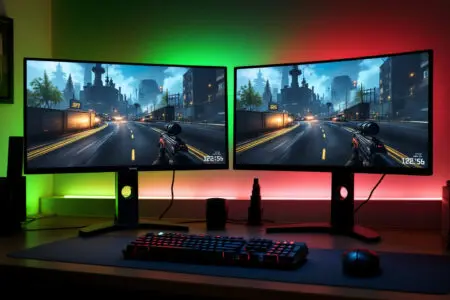My first real gaming monitor was a game-changer. I still remember that day. For years, I’d been perfectly happy on a hand-me-down office display, chugging along in my 1080p world. But plugging in that new 1440p screen? A total revelation. Suddenly, the world was sharper. Textures had a depth I never knew existed. Everything just… popped.
That was the moment it clicked for me: our hardware is just as vital to the experience as the game itself. It’s a journey every PC builder eventually takes. You find yourself at a crossroads, staring down three numbers: 1080, 1440, and 2160. This choice will define your entire gaming setup, from the GPU you hunt down to the immersion you feel. So, that question echoes across every forum and build guide out there: what is the best resolution for gaming? There isn’t one simple answer, but we can definitely figure it out together.
More in Monitors Category
What is the Best Monitor Panel Type for Gaming
Key Takeaways
- 1080p (Full HD): Still the top choice for competitive players and anyone building on a budget. It’s the easiest way to get those buttery-smooth high frame rates where speed is everything.
- 1440p (QHD): This is the sweet spot for most people. You get a huge, obvious visual upgrade from 1080p, but you don’t need to sell a kidney to buy a graphics card that can run it well.
- 4K (UHD): The peak of eye candy. If you want games to look as close to real life as possible and have a monster PC to handle it, 4K is your target.
- The Constant Battle: It always comes down to this: pretty graphics (resolution) vs. smooth gameplay (FPS). More pixels means your graphics card works harder, usually resulting in fewer frames per second.
- Your GPU Has the Final Say: Your graphics card is the most important piece of this puzzle. Seriously, don’t buy a 4K screen if you’re using a budget GPU. You won’t have fun.
So, What Exactly Are We Talking About With “Resolution”?
Before we get too far, let’s make sure we’re on the same page. When people say “resolution,” they’re just talking about how many tiny dots, or pixels, make up the picture on your screen. It’s a simple grid, width by height.
- 1080p (Full HD): 1920 pixels wide by 1080 pixels tall. That’s just over 2 million pixels in total.
- 1440p (Quad HD): 2560 by 1440. Now we’re talking about a much bigger canvas with almost 3.7 million pixels.
- 4K (Ultra HD): 3840 by 2160. This is a massive leap to nearly 8.3 million pixels.
Imagine you’re making a picture with mosaic tiles. The more tiles you use, the sharper and more detailed your image can look. Your graphics card is the artist that has to paint every single one of those tiles, over and over, dozens of times a second. Suddenly it makes sense why jumping from 1080p to 4K is such a workout for your PC—it’s handling four times the workload.
Does More Pixels Always Mean a Better Picture?
Pretty much, but it’s not the whole story. How sharp a screen looks also depends on its physical size and how far away you’re sitting. We call this pixel density, or PPI (Pixels Per Inch). A 24-inch 1080p monitor has a respectable PPI, and the image looks nice and crisp. But if you take that same 1080p resolution and blow it up on a 32-inch screen, the individual pixels get bigger and easier to see. The picture starts to look fuzzy. This is a huge reason why matching your monitor size to your resolution is so important.
Is 1080p Gaming Still Worth It in 2025?
One hundred percent. Don’t listen to the naysayers declaring 1080p is dead. For a huge slice of the PC gaming world, it’s not just hanging on; it’s the smartest pick. There’s a good reason it’s still the most common resolution, and that reason is speed.
Why Do Pro Gamers Swear By 1080p?
In competitive gaming, performance is king. Think about games like Valorant, Counter-Strike 2, or Apex Legends. Seeing an opponent a split-second sooner or tracking them perfectly across your screen is what wins gunfights. At 1080p, even a decent graphics card can pump out ridiculously high frame rates. This lets players use those super-fast gaming monitors—240Hz, 360Hz, you name it.
I went through a serious Valorant phase, and I know this firsthand. I specifically bought a 24-inch, 1080p 240Hz monitor instead of a prettier 1440p one. I wasn’t there to admire the art style; I was there to click on heads. The incredibly smooth motion and the feeling of a 1-to-1 connection with my mouse felt like an unfair advantage. Everything was just… instant. That’s the edge 1080p gives you.
Can My Wallet Breathe a Sigh of Relief with 1080p?
Your wallet can go into a deep and peaceful hibernation. Getting into 1080p gaming is way, way cheaper than aiming for higher resolutions. Great 1080p monitors don’t cost a fortune, and you don’t need some mythical, thousand-dollar graphics card for a great experience. You can put together a killer 1080p gaming rig for what a single high-end 4K-focused GPU costs. If you’re on a budget or you just value frame rate over everything, 1080p is the obvious choice.
Could 1440p Be the Goldilocks of Gaming Resolutions?
For the longest time, it felt like you had to choose between the high performance of 1080p and the beautiful visuals of 4K. It was either a fast, blurry mess or a gorgeous slideshow. Then 1440p started to get popular, and it changed everything. It’s now the new benchmark for a fantastic PC gaming setup, a perfect middle ground where you don’t feel like you’re making a huge sacrifice.
What Was It Like Jumping From 1080p to 1440p?
It was like getting glasses for the first time. I told you about my first 1440p monitor, but let me really paint the picture. The first game I booted up was Cyberpunk 2077, which is famous for its dense, detailed world. The second I walked out into Night City, I was blown away. Neon signs that were a bit fuzzy before were now razor-sharp.
I could actually read the text on far-off billboards. The little details—the texture on a jacket, the chrome finish on a gun, the grit on a wet street—all had a new level of clarity. It felt less like I was playing a game and more like I was looking out a window. That feeling is the promise of 1440p.
How Much GPU Power Do I Really Need for 1440p?
Okay, this is where you start to spend a bit more money, but we’re not in crazy territory yet. You’re asking your GPU to push almost 80% more pixels than 1080p, so it needs to have some horsepower. A good mid-range card from NVIDIA or AMD will get the job done, letting you play most new games on high settings with a solid 60+ FPS. A beefier card will, of course, let you max everything out and use a 144Hz monitor to its full potential. It’s a noticeable price jump from a 1080p build, but for millions of gamers, the visual upgrade is easily worth it.
Is This the Sweet Spot for Most Gamers?
I think so. 1440p really does strike a beautiful balance. You get a huge, obvious improvement in sharpness that makes games look incredible, especially on a 27-inch screen. But at the same time, getting high frame rates is still achievable without a top-tier PC. You can enjoy the breathtaking views in single-player epics like Baldur’s Gate 3 and still have the performance you need for a slick, responsive feel in multiplayer games. It’s the best of both worlds, and that’s why it’s become the new standard for so many.
Is Gaming in 4K Really the Dream It’s Made Out to Be?
4K is the stuff of marketing dreams. It’s what you see on the back of the box, in those perfect screenshots that look better than photos. It’s the absolute peak of visual detail, an experience so sharp it can stop you in your tracks. But that beautiful dream comes with a steep entry fee and a dose of reality.
How Jaw-Dropping Are 4K Visuals in Person?
They’re stunning. There’s no other word for it. At 4K, the whole idea of “pixels” just vanishes. You can’t see the individual dots on the screen. This gives you an image with incredible clarity and smoothness. Playing something like Red Dead Redemption 2 or Microsoft Flight Simulator in 4K is an event. You notice the individual blades of grass, the fine stitching on clothes, and distant mountains look just as clear as the rocks at your feet. All the distracting jagged edges you might see at lower resolutions are just gone. It’s as close to photorealism as we’ve ever been.
What’s the Brutal Truth About Running Games at 4K?
The hard truth? It’s a monster to run. I learned this lesson myself. A couple of years back, I got a new job and decided to celebrate by building a PC with no compromises, including a fancy 4K monitor. I bought one of the most powerful graphics cards you could get at the time and thought I was set. I booted up a demanding new game, set everything to “Ultra,” and watched my frame rate struggle to stay at 40 FPS.
I was crushed. I quickly realized that even with an expensive GPU, I would often have to turn down settings to get the smooth 60 FPS I craved. Forcing a GPU to render 8.3 million pixels 60 times a second is an enormous job. It takes the absolute best and most expensive hardware to do it well.
What Else Should I Consider Besides the Resolution Itself?
This choice isn’t made in a bubble. A couple of other big factors will influence how good your games look and feel. Nailing these details will help you avoid that awful feeling of buyer’s remorse.
Does My Monitor’s Size Actually Matter?
It matters more than you might think. Like we talked about with PPI, you need to match your screen size to your resolution. Cramming a high resolution onto a tiny screen is kind of a waste, and stretching a low resolution across a giant screen looks like a blurry mess. Here are some solid rules of thumb:
- 1080p: Looks great on monitors up to 24 inches. It starts to look a bit pixelated to some on a 27-inch screen.
- 1440p: The perfect partner for 27-inch monitors. This is where you really see the benefit of the extra pixels. It holds up well on 32-inch screens, too.
- 4K: Best on monitors 28 inches and up. On a 32-inch screen or larger, the clarity is just unreal.
Can Technologies Like DLSS and FSR Be My Secret Weapon?
They’re not just a secret weapon; they’re your superpower. Upscaling tech like NVIDIA’s DLSS and AMD’s FSR have completely changed the game, especially for 1440p and 4K. Put simply, they let your PC render the game at a lower resolution (which is easier) and then use smart AI to scale it up to your screen’s native resolution. The result is a huge boost in FPS with an image quality that is often almost identical to the real thing. For many people, these tools are what make high-resolution gaming possible.
What’s More Important: Refresh Rate (Hz) or Resolution?
Ah, the age-old debate: pretty vs. smooth. Your monitor’s refresh rate (in Hz) is how many times it redraws the image every second. A basic monitor is 60Hz, but gaming screens can go to 144Hz, 240Hz, or even higher. More Hz means smoother motion and a more responsive feel. Which one is better really comes down to your priorities. If you play competitive shooters, a high refresh rate is way more important. If you’re all about getting lost in cinematic worlds, a higher resolution will do more for your immersion.
So, How Do I Choose the Right Resolution for Me?
Alright, we’ve gone over the tech, the cost, and the personal stories. Now it’s time to figure out what’s best for you. Just answer these questions honestly, and the right choice should become clear.
Are You a Competitive FPS Player?
If you live and breathe for climbing the ladder in fast-paced shooters, your choice is simple. Go with 1080p. It’s the best way to get the highest frame rate and the lowest input lag, giving you the fastest, most responsive setup possible. A 24-inch, 1080p monitor with a 240Hz+ refresh rate is a top-tier competitive rig.
Do You Crave Immersive, Beautiful Worlds?
If you love exploring vast open worlds, getting lost in a good story, or commanding armies in a complex strategy game, then 1440p is calling your name. It delivers that “wow” factor, making game worlds feel crisp, detailed, and alive. It’s the best way to get a premium, immersive experience without needing a loan for your GPU. Many, including myself, feel that a 27-inch, 1440p, 144Hz+ monitor is the peak of PC gaming today. For more on the science of these displays, Purdue University’s Computer Graphics Technology program has some great academic resources.
Are You Building a No-Compromise, Top-of-the-Line Rig?
If you’re a hardware nut, you want the absolute best image quality money can buy, and your budget has plenty of room, then it’s time to enter the world of 4K. Know that you’ll be spending big on a flagship graphics card, but your prize is an image so clear it can look like real life. It’s the ultimate visual feast and the clear choice for the gamer who accepts no compromises.
Let’s boil it down to a final checklist. Just think about these four things:
- My Budget: Am I trying to save money, do I have a decent amount to spend, or am I going all-out?
- My GPU: What graphics card do I already have, or what’s the most I’m willing to pay for one?
- My Games: Am I playing sweaty, fast-paced shooters or gorgeous, cinematic adventures?
- My Priority: Do I care more about silky-smooth gameplay or incredible visual detail?
In the end, there’s no single “best” resolution for everyone. The right choice is the one that fits your PC, your wallet, and—most importantly—the kind of fun you want to have. Whether you’re chasing high scores at 300 FPS in 1080p or just stopping to admire the view in a 4K world, you’re doing it right. Pick the path that makes you want to boot up and play. Happy gaming.
FAQ – What is The Best Resolution for Gaming

Can I enjoy 4K gaming with my current hardware?
While you can, 4K gaming demands a very powerful graphics card to run smoothly at high settings, and you might need to lower settings or use upscaling technologies like DLSS or FSR for better performance.
What are the benefits of choosing 1440p over 1080p or 4K?
1440p offers a sweet spot with noticeable visual improvements over 1080p without the high hardware demands of 4K, making it ideal for most gamers seeking detailed graphics and good performance.
Does higher resolution always mean better game visuals?
Generally, yes, but the perceived quality also depends on monitor size and pixel density; larger screens with the same resolution can look less sharp, making matching your monitor size to your resolution important for optimal clarity.





